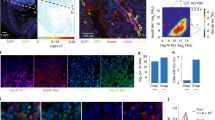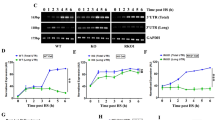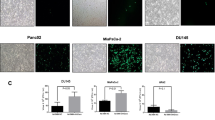Abstract
The simian double strand DNA tumor virus SV40 encodes the 90-kDa multi-functional protein, large T antigen (LT). LT functions by binding to DNA, as well as to many cellular target proteins such as p53 and retinoblastoma protein (pRB). We report here the identification of a cellular heat shock protein, HSP90, as a previously undescribed LT-associated protein. Immunoprecipitates by anti-HSP90 antibodies from LT-expressing cell lysates contained LT protein, as revealed by Western blotting. Conversely, anti-LT antibody co-immunoprecipitated HSP90. Co-immunoprecipitation of HSP90 and LT was observed even after complete immuno-depletion of p53, indicating that the association of LT with HSP90 is p53-independent. LT-HSP90 complexes can be reconstituted from purified HSP90 and unfolded-LT in vitro in an ATP-independent manner but not from HSP90 and native LT, suggesting that non-mature conformation of LT is required for the efficient association with HSP90. Moreover, geldanamycin, an anti-tumor drug that specifically binds and inhibits HSP90, reduced the intracellular concentration of LT by destabilizing newly synthesized LT. The above results suggest that HSP90 associates with immature forms of LT both in vivo and in vitro, and thus might assist LT in the formation of a functional, mature structure.
This is a preview of subscription content, access via your institution
Access options
Subscribe to this journal
Receive 50 print issues and online access
$259.00 per year
only $5.18 per issue
Buy this article
- Purchase on Springer Link
- Instant access to full article PDF
Prices may be subject to local taxes which are calculated during checkout






Similar content being viewed by others
References
Adamczewski JP, Gannon JV and Hunt T . 1993 J Virol 67: 6551–6557
Aligue R, Akhavan-Niak H and Russell P . 1994 EMBO J 13: 6099–6106
Avantaggiati ML, Carbone M, Graessmann A, Nakatani Y, Howard B and Levine AS . 1996 EMBO J 15: 2236–2248
Blagosklonny MV, Toretsky J, Bohen S and Neckers L . 1996 Proc Natl Acad Sci USA 93: 8379–8383
Brugge JS, Erikson E and Erikson RL . 1981 Cell 25: 363–372
Buchner J . 1999 Trends Biochem Sci 24: 136–141
Campbell KS, Mullane KP, Aksoy IA, Stubdal H, Zalvide J, Pipas JM, Silver PA, Roberts TM, Schaffhausen BS and DeCaprio JA . 1997 Genes Dev 11: 1098–1110
Catelli MG, Binart N, Jung-Testas I, Renoir JM, Baulieu EE, Feramisco JR and Welch WJ . 1985 EMBO J 4: 3131–3135
Csermely P, Schnaider T, Söti C, Prohászka Z and Nardai G . 1998 Pharmacol Ther 79: 129–168
Cutforth T and Rubin GM . 1994 Cell 77: 1027–1036
DeCaprio JA, Ludlow JW, Figge J, Shew JY, Huang CM, Lee WH, Marsilio E, Paucha E and Livingston DM . 1988 Cell 54: 275–283
Dixon RA and Nathans D . 1985 J Virol 53: 1001–1004
Dyson N, Buchkovich K, Whyte P and Harlow E . 1989 Cell 58: 249–255
Fanning E . 1992 J Virol 66: 1289–1293
Frydman J and Höhfeld J . 1997 Trends Biochem Sci 22: 87–92
GarcÃa-Cardeña G, Fan R, Shah V, Sorrentino R, Cirino G, Papapetropoulos A and Sessa WC . 1998 Nature 392: 821–824
Harlow E, Crawford LV, Pim DC and Williamson NM . 1981 J Virol 39: 861–869
Hedge RS, Zuo J, Voellmy R and Welch WJ . 1995 J Cell Physiol 165: 186–200
Hendrick JP and Hartl FU . 1993 Annu Rev Biochem 62: 349–384
Holt SE, Aisner DL, Baur J, Tesmer VM, Dy M, Ouellette M, Trager JB, Morin GB, Toft DO, Shay JW, Wright WE and White MA . 1999 Genes Dev 13: 817–826
Hu J and Seeger C . 1996 Proc Natl Acad Sci USA 93: 1060–1064
Jakob U and Buchner J . 1994 Trends Biochem Sci 19: 205–211
Jeoung DI, Chen S, Windsor J and Pollack RE . 1991 Genes Dev 5: 2235–2244
Joab I, Radanyi C, Renoir M, Buchou T, Catelli M-G, Binart N, Mester J and Baulieu E-E . 1984 Nature 308: 850–853
Kalderon D, Richardson WD, Markham AF and Smith AE . 1984 Nature 311: 33–38
Kelley WL and Landry SJ . 1994 Trends Biochem Sci 19: 277–278
Kimura G, Itagaki A and Summers J . 1975 Int J Cancer 15: 694–706
Koyasu S, Nishida E, Kadowaki T, Matsuzaki F, Iida K, Harada F, Kasuga M, Sakai H and Yahara I . 1986 Proc Natl Acad Sci USA 83: 8054–8058
Lane DP and Crawford LV . 1979 Nature 278: 261–263
Lindquist S and Craig EA . 1988 Annu Rev Genet 22: 631–677
Linzer DI and Levine AJ . 1979 Cell 17: 43–52
Ludlow JW . 1993 FASEB J 7: 866–871
Mayer MP and Bukau B . 1999 Curr Biol 9: R322–R325
Miyata Y and Yahara I . 1992 J Biol Chem 267: 7042–7047
Miyata Y and Yahara I . 1995 Biochemistry 34: 8123–8129
Oppermann H, Levinson W and Bishop JM . 1981 Proc Natl Acad Sci USA 78: 1067–1071
Pinhasi-Kimhi O, Michalovitz D, Ben Zeev A and Oren M . 1986 Nature 320: 182–184
Pipas JM . 1992 J Virol 66: 3979–3985
Rutherford SL and Zuker CS . 1994 Cell 79: 1129–1132
Sanchez ER, Toft DO, Schlesinger MJ and Pratt WB . 1985 J Biol Chem 260: 12398–12401
Sawai ET and Butel JS . 1989 J Virol 63: 3961–3973
Schumacher RJ, Hurst R, Sullivan WP, McMahon NJ, Toft DO and Matts RL . 1994 J Biol Chem 269: 9493–9499
Shaknovich R, Shue G and Kohtz DS . 1992 Mol Cell Biol 12: 5059–5068
Simanis V and Lane DP . 1985 Virology 144: 88–100
Smale ST and Tjian R . 1986 Mol Cell Biol 6: 4077–4087
Srinivasan A, McClellan AJ, Vartikar J, Marks I, Cantalupo P, Li Y, Whyte P, Rundell K, Brodsky JL and Pipas JM . 1997 Mol Cell Biol 17: 4761–4773
Stancato LF, Chow Y-H, Hutchison KA, Perdew GH, Jove R and Pratt WB . 1993 J Biol Chem 268: 21711–21716
Tjian R, Robbins A and Clark R . 1980 Cold Spring Harbour Symp Quant Biol 44: 103–111
Toft DO . 1998 Trends Endocrin Metabol 9: 238–243
Uehara Y, Hori M, Takeuchi T and Umezawa H . 1986 Mol Cell Biol 6: 2198–2206
Welch WJ . 1992 Physiolog Rev 72: 1063–1081
Whitesell L, Mimnaugh EG, De Costa B, Myers CE and Neckers LM . 1994 Proc Natl Acad Sci USA 91: 8324–8328
Whitesell L, Sutphin PD, Pulcini EJ, Martinez JD and Cook PH . 1998 Mol Cell Biol 18: 1517–1524
Wiech H, Buchner J, Zimmermann R and Jakob U . 1992 Nature 358: 169–170
Yahara I, Minami Y and Miyata Y . 1998 Ann NY Acad Sci 851: 54–60
Yang J and DeFranco DB . 1994 Mol Cell Biol 14: 5088–5098
Zou J, Guo Y, Guettouche T, Smith DF and Voellmy R . 1998 Cell 94: 471–480
Acknowledgements
We thank Dr E Nishida for encouragement and support, and Drs Y Minami and Y Kimura for their helpful comments. We thank Dr Y Murakami (RIKEN) and Dr G Kimura (Kyushu University) for kindly providing us with cell lines. We thank Ms K Sakakibara and Ms K Kimura for their technical assistance. This work was supported in part by a CREST research project and by grants-in-aid from the Ministry of Education, Science and Culture of Japan.
Author information
Authors and Affiliations
Rights and permissions
About this article
Cite this article
Miyata, Y., Yahara, I. p53-independent association between SV40 large T antigen and the major cytosolic heat shock protein, HSP90. Oncogene 19, 1477–1484 (2000). https://doi.org/10.1038/sj.onc.1203475
Received:
Revised:
Accepted:
Published:
Issue Date:
DOI: https://doi.org/10.1038/sj.onc.1203475
Keywords
This article is cited by
-
Diversity in heat shock protein families: functional implications in virus infection with a comprehensive insight of their role in the HIV-1 life cycle
Cell Stress and Chaperones (2021)
-
HSP90: a promising broad-spectrum antiviral drug target
Archives of Virology (2017)
-
Viral interaction with molecular chaperones: role in regulating viral infection
Archives of Virology (2010)
-
CK2 binds, phosphorylates, and regulates its pivotal substrate Cdc37, an Hsp90-cochaperone
Molecular and Cellular Biochemistry (2005)



